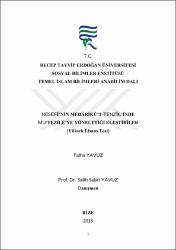| dc.description.abstract | Kelâm ilmi, inanç konularını sahih bir biçimde ele almak, dinde de beraberliği sağlamak için akli ve nakli delilleri kullanmıştır. Fakat bu çaba farklı fırkaların zuhur etmesine engel olamamış, bilakis her fırka kendi görüşlerinin doğruluğunu, karşıt görüşlerin yanlışlığını ispat etme yoluna gitmiştir. Hatta çoğu kez aynı ayetle istidlal edilmesine rağmen, her mezhep mensubu âyeti kendi itikadına göre te'vil ederek, karşı tarafı ilzam etmeye çalışmıştır. Bu tezde, Ebu'l-Berekât en-Nesefî'nin (ö. 710/1310) Mu'tezile'yi tenkit ettiği âyetler ve kelâmi açıdan izahları konusu incelenmiştir. Çalışma üç bölümden oluşmaktadır. Birinci bölümde Ebu'l-Berekât en-Nesefî'nin hayatı ve eserleri anlatılmaktadır. İkinci bölümünde ana kaynağımız olan ve Nesefî'nin en meşhur eseri olan 'Medârikü't-Tenzîl ve Hakâiku't-Te'vîl' adlı tefsiri tanıtılarak, kullandığı kaynakları, metodu vb. bazı yönleri incelenmiş ve hususiyetleri izah edilmiştir. Üçüncü bölümde de, araştırmamızın ana konusu olan, Nesefî'nin Mu'tezile'ye yönelttiği eleştiriler ve bunların kelâmi yönden izahları ele alınmıştır. Ulaşmış olduğumuz netice itibariyle, Ehl-i Sünnet ile Mu'tezile'nin itikadi olarak birçok meselede farklı düşündükleri sonucu tesbit edilmiştir. Usullerinin ve kullandıkları delillerin farklı olması veya aynı delilin farklı yorumlanması, neticenin değişik olmasındaki önemli faktörlerden sadece birkaçıdır. Kalam science, used mental and transitory documents for handling faith subjects in form and providing the equalization at religion. But this endeavor can not prevent the emergence of different factions contrary each group tried to prove the truth of their own belief and the falsities of opposite wievs. In spite of the fact that it is often supplied the same verse as proof from each group and every party has tried to defend the opposite side by provoking the verse according to its own belief. İn this thesis the verses of Ebu'l-Berekat en-Nasafi (died 710/1310) that criticised the Mu'tezile and explanations from the point of Kalam are explained. The work consists of three parts. In the first part, the life and works of Abu'l- Berekat en-Nasafi are explained. In the second part, we introduce our main source, Nasafi's most famous work, 'Medâriku't-Tenzil and Hakaiku't-Te'vil's sources, methods, some aspects detailed and their characteristics explained. In the third chapter, the main subject of our research, the verses of Nasafi criticized by Mu'tazila, and their explanations of the kelami aspect are discussed. As a result of our research, we have determined that the Ahl-i Sunnah and Mu'tazila differ in many aspects as a belief. They used different ways in procedures and the evidence they use are different, or the different interpretation for the same evidence, are just some of the important factors in the variation of the result. | en_US |


















